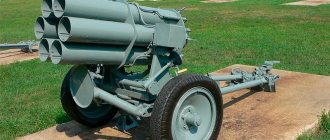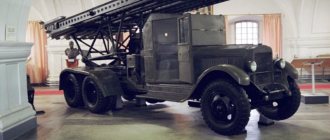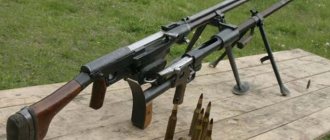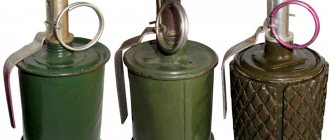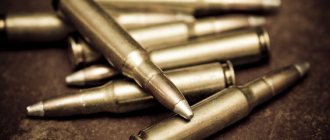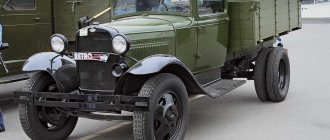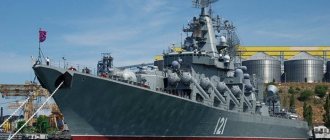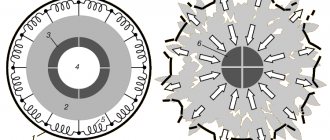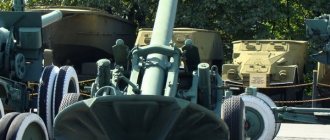Author: Ivan Rzhanov
06 November 2022 21:35
Tags: USSR war Katyusha shelling
7052
10
1
On June 21, 1941, the Red Army adopted rocket artillery - BM-13 Katyusha launchers.
0
See all photos in the gallery
Among the legendary weapons that became symbols of our country’s victory in the Great Patriotic War, a special place is occupied by guards rocket mortars, popularly nicknamed “Katyusha”. The characteristic silhouette of a truck from the 40s with an inclined structure instead of a body is the same symbol of perseverance, heroism and courage of Soviet soldiers as, say, the T-34 tank, Il-2 attack aircraft or ZiS-3 cannon. And here’s what’s especially noteworthy: all these legendary, glorious weapons were designed very shortly or literally on the eve of the war! The T-34 was put into service at the end of December 1939, the first production IL-2s rolled off the production line in February 1941, and the ZiS-3 gun was first presented to the leadership of the USSR and the army a month after the start of hostilities, on July 22, 1941. But the most amazing coincidence happened in the fate of Katyusha. Its demonstration to the party and military authorities took place half a day before the German attack - June 21, 1941...
From the author
On July 14, 1941, the Germans, who had just occupied the city of Rudnya, heard a strange sound from the sky. And then all hell broke loose. Heavy fire from an unknown weapon turned the railway station into a cloud of fire. The chief of the German General Staff, Halder, wrote in his diary that day: “On July 14, near Orsha, the Russians used some new, hitherto unknown weapon. A barrage of mortar shells burned the Arshan railway station and all trains with equipment and personnel. The earth was burning. The metal was melting."
History of creation.
The development of the rocket mortar began back in 1921. Back then, rockets were developed for aircraft. However, later the RS-82 projectile was created. This is an 82-mm rocket, used on fighter aircraft of those years. And in 1939, domestic engineers came up with the idea of creating an automobile mortar installation.
In March 1941, field tests of the installations, designated BM-13, which stands for “Combat vehicle with 132 mm caliber shells,” were successfully carried out. The RS-132 caliber rocket and launcher based on the ZIS-6 truck were put into service on June 21, 1941. It was this type of combat vehicle that first received the nickname “Katyusha”. In essence, the BM-13 is not a mortar. They were called that for purposes of conspiracy. The installation was so secret that everyone who served on it was thoroughly checked. And then they took the oath. However, these fighters, among other things, swore to destroy it in the event of damage, breakdown, encirclement, or other threats of the vehicle being captured by the enemy. For this purpose, a 30-kilogram TNT charge was standardly placed on the vehicle. Needless to say, even during testing it was forbidden to give the commands “Fire”, “Fire”, “Volley”. Instead, the code words "Sing" and "Play" were used.
It is not known for certain where the name of the mortar came from. There are many versions. Thus, the main version is that the BM-13 was named after the name of Blanter’s song, which became popular before the war, based on the words of Isakovsky “Katyusha”. The version is convincing, since for the first time Captain Flerov’s battery fired at the enemy on July 14, 1941 at 10 a.m. The mounts were fired from a high steep mountain - the association with the high steep bank in the song immediately arose among the soldiers. The second version is associated with the “K” index on the mortar body. They were placed as the factory logo of the Comintern plant. Front-line soldiers loved to give nicknames to their weapons. At first, even “Katyusha” was called “Raisa Sergeevna”, according to the markings of the RS-132 shells.
Weapon of Victory: BM-13 legendary “Katyusha”
- Articles
- 11 April 2022, 09:00
As part of the “Weapons of Victory” series, the Internet portal “Kuban24” talks about the BM-13 multiple launch rocket system, which Soviet soldiers affectionately called “Katyusha”. There is also a lesser known nickname - “Raisa Sergeevna”. The Germans called it “Stalin’s organ” for its characteristic sound upon launch.
No analogues, no competitors
City of Orsha. July 14, 1941. First use of BM-13. The Nazis were so stunned by the fiery hell that the explosions of Katyusha rockets created over entire hectares of territory that in reports to their superiors they wrote about “the newest unprecedented Russian weapon.”
The flight range of the BM-13 missiles was 8.5 km, and the temperature at the epicenter of the explosion was 1.5 thousand °C. The Germans repeatedly tried to capture a captured Katyusha model, but due to their flight range, the BM-13s were always located far enough to the rear behind the front line. In addition, all units were ordered to destroy installations in the event of a possible capture so that they would not fall to the enemy. Later, each Katyusha was equipped with a self-destruction system - this is how secret developments were protected from the Nazis.
The BM-13 was very accurate: the maximum lateral deviation was 51 meters, and the range deviation was a maximum of 257 meters. "Katyusha" entered combat mode from the stowed mode in record time - in 3 minutes. A salvo of 16 rockets was fired in 7-10 seconds.
Artillery units armed with BM-13 were considered elite, they immediately received the name Guards. “Katyushas” were called guards mortars in official military documents.
The crew of the BM-13 consisted of a gun commander, a gunner, a driver and 2-4 loaders. For a long time, a big problem was training cadets and soldiers to control and fire Katyushas. Sometimes the release of rocket mortars outpaced the number of trained personnel.
Until the end of the war, neither the Nazis nor the Western allies were able to create a direct analogue of the BM-13. The British and Americans had rockets, the Nazis had mortars for rockets, but foreign inventors never presented a serial version of the installation.
The Wehrmacht tried to convert its Nebelwerfer chemical weapons missile launcher (translated from German as “fog gun”) into rocket launchers. But the result turned out to be so pitiful that our soldiers contemptuously nicknamed Nebelwerfer “donkey” and “creaky one.”
Every major Soviet offensive began with massive salvoes of BM-13s. To burn an area of 100 hectares with continuous fire, one salvo of an artillery regiment was required - 576 shells.
Born on the eve of the war
In 1938, the USSR Air Force received two missiles - 82 mm air-to-air and 132 mm air-to-ground. In June 1938, the Main Artillery Directorate set the task for the Jet Research Institute to develop a field multiple launch rocket system. By the summer of 1939, the institute had developed a new 132 mm high-explosive fragmentation projectile, the M-13.
Compared to previous models, it had a longer flight range and a more powerful warhead. For the M-13, they developed a self-propelled reusable launcher based on the ZIS-5 truck. Field testing and refinement began.
On June 21, 1941, the day before the start of the war, the installation was demonstrated to the top leadership of the USSR and, after approval, it was immediately put into production. The weapon was given the name BM-13. This is how the full name “Combat Machine – 13” was shortened. The soldiers first nicknamed the installation “Raisa Sergeevna” for the inscription on the RS (missile) shells, and then “Katyusha” for the loud and piercing sound of its murderous “voice”, by analogy with their favorite song. The Nazis called the BM-13 “Stalin’s organ” for its characteristic howl when launching a projectile.
In 1941, 593 units were produced. During all the years of the war - 6 thousand 800 pieces. Of these, 1,400 were damaged, destroyed, or exhausted by the end of the war. Also, 12 million shells were fired at the BM-13 over four years of hostilities. “Katyushas” were made at factories in Moscow and Voronezh. After their evacuation, the production of “Raisa Sergeevna” was mastered by a number of factories.
The creators and carriers of the Katyusha rocket of the USSR
With the start of deliveries under Lend-Lease, the BM-13 began to be installed on American cars Studebaker, GMC, International Ford - Marmon - Herrington, Chevrolet. In addition, Canadian and British Dodge, Bedford and Austin chassis were used. The most ideal truck for Katyushas was the legendary Studebaker US6 - its cross-country ability, power and wheel clearance were ideally combined with the installation of the BM-13.
In addition to trucks, Katyushas were installed on tanks. The largest number of them were in Soviet units under the command of General Chuikov, who participated in the Battle of Stalingrad. They were also mounted on railway handcars (defense of Sochi from the sea) and on ships (Malaya Zemlya, Novorossiysk), and mountain units had portable installations, which were first used in the battles for Tuapse in 1942.
“Raisa Sergeevna” made the greatest contribution to the successful actions of the Red Army near Moscow, in the Battle of Stalingrad and in the capture of Berlin. But the use of Katyushas in the Battle of Kursk was considered a failure - the BM-13 shells were high-explosive fragmentation, not armor-piercing.
A number of domestic engineers and designers contributed to the creation of the famous rocket mortar - Georgy Langemak (was shot in 1938), Boris Petropavlovsky, Vladimir Artemyev, Nikolai Tikhomirov, Yuri Pobedonostsev, Kerim Kerimov, Andrey Kostikov. The greatest contribution to the development of the BM-13 system itself was made by Artemyev and Tikhomirov. The rest were engaged in the creation of rockets for the Katyusha and its modification.
After the Great Patriotic War, BM-13s were used in military conflicts twice - during the Korean War and in Afghanistan. They were replaced by more advanced models of rocket launchers. In 1980, Katyushas were officially removed from service with the Soviet Army.
Authors: Alexey Kulikov
Installation design
Like any weapon of victory, Katyusha is extremely simple. In fact, it is just a set of rail guides, electrical wiring and an artillery sight. The number of guides ranged from 12 to 48 depending on the carrier vehicle.
The chassis on which the unit was mounted were very different. Initially it was mounted on three-axle ZIS-6 trucks. Later they began to be installed on armored trains, the STZ-5-NATI tracked tractor, and even the T-60 light tank. In general, to everything that could carry her and survive the salvo. However, Katyusha worked best with the American Studebaker US6 truck, which was supplied to the USSR under Lend-Lease. Officially, the Studebaker had a load capacity of 2.5 tons, but Soviet inspectors recommended a load of 4 tons. All parts of the car sensitive to water were located quite high. This greatly influenced the decision to make it the main means of transporting Katyusha rocket launchers.
On land and sea...
In addition to the BM-13, in the SKB of the Voronezh plant. The Comintern, which produced these combat installations, developed new options for placing missiles. For example, taking into account the extremely low cross-country ability of the ZIS-6 vehicle, an option was developed for installing guides for missiles on the chassis of the STZ-5 NATI tracked tractor. In addition, an 82 mm caliber rocket has also found use. Guides were developed and manufactured for it, which were later installed on the chassis of the ZIS-6 vehicle (36 guides) and on the chassis of the T-40 and T-60 light tanks (24 guides).
A 16-charging installation for RS-132 shells and a 48-charging installation for RS-82 shells for armored trains were developed. In the fall of 1942, during the fighting in the Caucasus, 8-round mining pack launchers for RS-82 shells were manufactured for use in mountain conditions.
Later they were installed on American Willys all-terrain vehicles, which came to the USSR under Lend-Lease. Special launchers for 82 mm and 132 mm caliber missiles were manufactured for their subsequent installation on warships - torpedo boats and armored boats.
The launchers themselves received the popular nickname “Katyusha”, under which they entered the history of the Great Patriotic War. Why Katyusha? There are many versions on this matter. The most reliable - due to the fact that the first BM-13 had the letter “K” - as information that the product was produced at the plant named after. Comintern in Voronezh. By the way, the cruising boats of the Soviet Navy, which had the letter index “K,” received the same nickname. In total, 36 launcher designs were developed and produced during the war.
And the Wehrmacht soldiers nicknamed the BM-13 “Stalin's organs.” Apparently, the roar of the rockets reminded the Germans of the sounds of a church organ. This “music” clearly made them feel uncomfortable. And from the spring of 1942, guides with missiles began to be installed on British and American all-wheel drive chassis imported into the USSR under Lend-Lease. Still, the ZIS-6 turned out to be a vehicle with low cross-country ability and carrying capacity. The three-axle all-wheel drive American truck Studebakker US6 turned out to be most suitable for installing rocket launchers. Combat vehicles began to be produced on its chassis. At the same time, they received the name BM-13N (“normalized”).
During the entire Great Patriotic War, Soviet industry produced more than ten thousand rocket artillery combat vehicles.
Combat experience
The Guards Mortar Regiment of the Reserve Artillery of the Supreme High Command consisted of a command, three divisions of three batteries of four installations. The Stavka directive prohibited the use of less than a Katyusha division. Thus, in its destructive power, a salvo from a division could be compared to a salvo from 12 heavy howitzer regiments, 48 152-mm howitzers per regiment.
The division's salvo lasted no more than 15 seconds - the shells came off the guides almost simultaneously. After this, the fighters hastily gathered and changed positions, hiding from the retaliatory strike. In one salvo, the division fired more than 500 shells, sowing death over an area of more than one hundred hectares. Due to the superposition of shock waves, they intensified, smashing everything in the affected area into dust. In addition, the shell fragments became so hot that they set everything around on fire. Hence the legend of the thermite charge. In fact, shells with “thermite” were tested near Leningrad, but there was no need for them - everything caught fire anyway.
German analogues.
It is difficult to call the German Nebelwerfer an analogue of the Katyusha. Its name translates as “Fog Thrower,” which suggests that it was not originally a mortar. The Germans created a mortar for the use of chemical weapons. But the launcher didn’t care what shells it fired.
The myth that “Vanyusha,” as our soldiers dubbed it, was developed in response to the BM-13 is far from the truth. Nebelwerfer appeared back in 1940. It turned out to be expensive, difficult to manufacture and did not have the required salvo range. And all because the Germans were unable to unravel the secret of gunpowder in the engine of the RS-132 shells. Even the fact that the captured installations were dismantled and completely examined did not help them. In the photo, Soviet soldiers are firing from a domestic copy of the “fog gun.”
And if the Germans had used our gunpowder, nothing would have happened. There are two reasons for this. The first is the low quality of materials. Our gunpowder simply melted the shell. And the second reason is that the Vanyusha projectile, due to its design features, spun up to 60,000 rpm. Due to this, high accuracy was achieved, but the range dropped to 6.8 kilometers. “Katyusha” did not really need accuracy - with a range of 8.5-9 kilometers, a massive salvo and a huge affected area.
The second analogue (doubtful, however) can be considered the German “Faustpatron”. This is the first anti-tank disposable grenade launcher. Another modification was the Panzerfaust. Compared to the little Faustpatron, it seemed like a formidable weapon. Indeed, the shaped charge burned through up to 20 centimeters of armor and killed the tank crew with a stream of hot gases and molten metal.
At the end of the war, almost all of Berlin was armed with Panzerfausts: even old grandmothers and children from the Hitler Youth were taught to use them. But the Russians found another use. Thus, there is a known case when a Russian soldier jumped into a German trench and, grabbing the first thing that came to hand, beat ten Wehrmacht soldiers to death. It turned out that the Panzerfaust was the formidable club in the hands of our soldier. The fighter simply didn’t know what it was.
The third analogue is rightfully considered the German FAU. In general, this is a separate family of cruise missiles, and they deserve a separate story. On the eastern front, FAUs were almost never used - they mainly fired at London. As a “weapon of retaliation,” these shells performed poorly due to imperfect design and astronomical cost.
Relatives of the Katyusha
For all their advantages, high-explosive fragmentation rockets RS-82 and RS-132 had one drawback - large dispersion and low efficiency when affecting enemy personnel located in field shelters and trenches. To correct this shortcoming, special 300 mm caliber rockets were manufactured. They received the nickname “Andryusha” among the people. They were launched from a launching machine (“frame”) made of wood. The launch was carried out using a sapper blasting machine. “Andryushas” were first used in Stalingrad. The new weapons were easy to manufacture, but installing them in position and aiming at the target required a lot of time. In addition, the short range of the M-30 rockets made them dangerous for their own crews.
Therefore, in 1943, the troops began to receive an improved rocket projectile, which, with the same power, had a greater firing range. An M-31 shell could hit manpower over an area of 2 thousand square meters or create a crater 2-2.5 m deep and 7-8 m in diameter. But the time to prepare a salvo with new shells was significant - one and a half to two hours. Such shells were used in 1944-1945 during the assault on enemy fortifications and during street battles. One hit from an M-31 rocket was enough to destroy an enemy bunker or a firing point located in a residential building.
Instead of an afterword
"Katyusha" became the mother of all domestic rocket mortars. The technical breakthrough made by domestic engineers is worthy of respect. And this makes the fate of the developers seem even more bitter and offensive. On November 2, 1937, as a result of a “war of denunciations” within the institute, the director of RNII-3, Kleimenov, and the chief engineer, Langemak, were arrested. On January 10, 1938, Kleimenov was shot. The next day, January 11, Langemak was also shot. The execution took place at the NKVD Kommunarka training ground. Both were rehabilitated in 1955.
